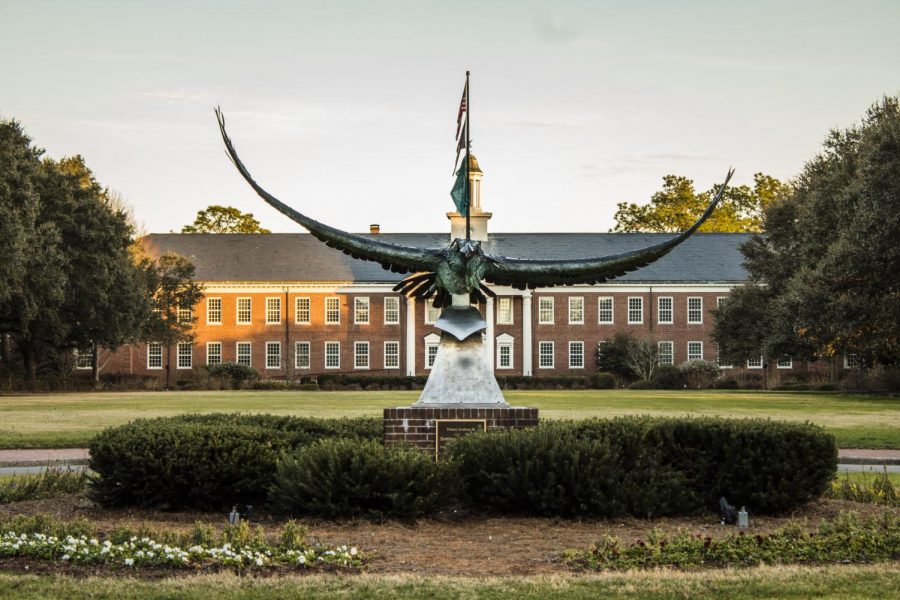UNCW extends spring break, transitions classes to online to combat coronavirus fears
All UNC-system schools, including UNC Wilmington, have extended their spring breaks to March 20 and will switch to remote learning on March 23. Athletics and gatherings involving more than 100 people have also been canceled.
The news first broke on Wednesday, March 11, 2020, the day the World Health Organization (WHO) formally declared a pandemic and America finally decided to impose a series of changes to daily life to combat the spread of the virus. Between 9:00 p.m. and 10:00 p.m. that day, three nasty headlines hit: actor Tom Hanks and his wife announcing that they were sick with COVID-19, the declaration of a national emergency by Trump and the suspension of the 2020 NBA season effective immediately.
The president has also banned travel from the U.K., Ireland and 26 other European countries. Europe is now the center of the pandemic, according to the WHO. Moreover, D.C. and eighteen states, including North Carolina, have ordered the closure of all public schools. Churches across the nation have shifted to online services. Even running races are facing cancellation, including the Boston Marathon which has been postponed to September 14, as the contagion from Wuhan now becomes a global emergency.
Many Americans are skeptical of the need for such drastic measures and will likely hesitate to take precautions beyond longer and more frequent hand washing and covering up sneezes and coughs unless legally required. Let’s debunk a few myths so that we can understand why these basic measures will not cut it this time.
Most of the misconceptions hinge on the mistaken belief that COVID-19 is not as bad as seasonal influenza. One of the top myths is that the coronavirus is not as deadly. According to ABC 11 Atlanta, the common flu has killed over 22,000 Americans and sickened at least 36 million others. As of March 14, 2020 at 01:45 GMT (21:45 EDT), only 5,835 deaths, 57 of them in the U.S., have been attributed to COVID-19. However, two factors quash this fallacy: a higher mortality rate, which has been estimated at six percent for COVID-19 patients over the age of 60 as well as a lack of herd immunity, as reported in an article from Vox.
“There is still considerable uncertainty around the fatality rates of COVID-19 and it likely varies depending on the quality of local healthcare,” said Francois Balloux, Professor of Computational Systems Biology at University College London, in an article for Science Alert. “That said, it is around two percent on average, which is about 20 times higher than for the seasonal flu lineages currently in circulation.”
In epidemiology, herd immunity refers to the gradual immunization of people against an outbreak as the disease in question infects more victims. Survivors of most bacterial and viral illnesses develop antibodies in their immune systems that guard against repeat infections for months to years.
Another popular myth is that the novel virus does not deserve the attention it has been receiving because 80 percent of cases result in only mild illness. While this statistic is mostly true, it fails to account for the high potential of someone with light symptoms accidentally spreading the virus to someone over 60 and/or with chronic health conditions.
“Immune function is not as robust as it is in younger people,” said Sean Leng, a geriatrician and a professor of medicine at the Johns Hopkins University School of Medicine in an article for Vox. “Studies over the years have shown that in most people, their immune function is pretty okay in their 60s, or even in their 70s. The immune functions go down rather quickly after age 75 or 80.” In addition to greater risk for respiratory failure, aging immune systems may overreact and produce what is known as a “cytokine storm,” which can lead to very high fever, organ failure and death.
So far, we have just covered bad news. Or did we? While social distancing is no celebratory matter, the aggressive tactics involved have been proven to be powerful weapons against contagious respiratory illnesses. And just last week (on March 5), an article was posted that claimed that “the US owes China an apology, the world owes China thanks” over both superpowers’ drastically differing stances on the pandemic. Fortunately, the introduction of social-distancing measures in America this week has rendered the article obsolete.
This is one of the first pandemics of the Internet age (besides swine flu, which did not warrant mass lockdowns and disruptions to daily life). Globalization and interdependence have made the containment of infectious disease harder. However, advances in science and technology will allow the world to fight to a degree that has never been seen in healthcare history. A Canadian company has claimed to create a COVID-19 vaccine, which should become available by November 2021 after clearing regulatory hurdles. Video-conferencing technologies and the ability to work from home will avert worst-case economic scenarios.
“The 1918 flu pandemic caused more than 25 million deaths in less than 25 weeks,” said Ignacio López-Goñi, a professor of microbiology and virology at the University of Navarra in Spain, in article to KIRO 7 Washington. “Could something similar happen now? Probably not; we have never been better prepared to fight a pandemic.”
Now back to the bad news. We can definitely fight back, but it will come at a heavy price.
A recession is predicted to hit the global economy at some point during 2020. Stocks and oil prices have experienced unprecedented fluctuations in recent days, with some drops rivaling the worst ones of the Great Recession. The travel, tourism and manufacturing industries are expected to suffer in the wake of social-distancing measures. The pandemic and its effects are impossible to predict as the global disaster still remains in its early stages.
“Unless this passes quickly, this would be worse for the economy than the [2007-2008] financial crisis,” said Jason Furman, an economics professor at Harvard University, in an article for The Hill. “In the financial crisis, most people kept their jobs. Many people maintained their spending. Now everyone is cutting their spending,” Furman continued. “Lots of people, if they don’t lose their jobs, are going to get substantial pay cuts in a potentially much more widespread way than the financial crisis.”
Fortunately, though, it is not expected to be as bad as the 2008 Great Recession.
That was caused by an unstable housing market and questionable bank practices, which had been ongoing for years. At the beginning of 2020, the American economy was extremely robust from years of growth. This recession is expected to last no more than six months, compared with 18 months a decade ago. Additionally, major banks have faced tighter regulation, including maintaining backup cash in the wake of the 2008 crisis.
“It’s a difference in severity,” says Yung-Yu Ma, chief investment strategist at BMO Wealth Management. “Capital requirements have put banks in a much more comfortable position to be able to withstand a major shock.”
Even with the Internet and limited economic impacts, however, the pandemic will certainly exacerbate America’s mental health crisis.
Research has strongly linked prolonged anxiety and loneliness to reduced immunity and premature death. The U.S. Health Resources and Services Administration has warned in January 2019 that chronic loneliness can be as harmful to health as smoking 15 cigarettes daily. The elderly are hardest hit; 27 percent live alone and 43 percent feel lonely on the regular. Also, the risk of mortality for lonely seniors is almost 50 percent higher than that of their non-lonely counterparts. To make matters worse, this demographic is most at risk for becoming critically or fatally ill with COVID-19.
“We’re now officially in a pandemic,” says Eric Klinenberg, a New York University sociologist who has studied the way social isolation leaves older Americans vulnerable in emergencies. “But we’ve also entered a new period of social pain. There’s going to be a level of social suffering related to isolation and the cost of social distancing that very few people are discussing yet.”
In addition to loneliness, constant panic and activations of the fight-or-flight response cause inflammation and fatigue to the immune system. This leads to greater susceptibility to infection as well as high blood pressure, heart disease and other chronic issues. Additionally, those recovering from obsessive-compulsive disorder will be at risk for regressing, especially as the CDC recommends that hand-washing be frequent and last at least 20 seconds at a time. Survivors of previous disasters may experience flashbacks and trauma, as may be the case for Hurricane Harvey survivors facing long home confinement for the second time.
These social-distancing measures may seem over the top, but remember that they are critical in saving lives and returning to normalcy as soon as possible.
This article has been modified since its original publishing in order to provide more accurate attributions and sources.








